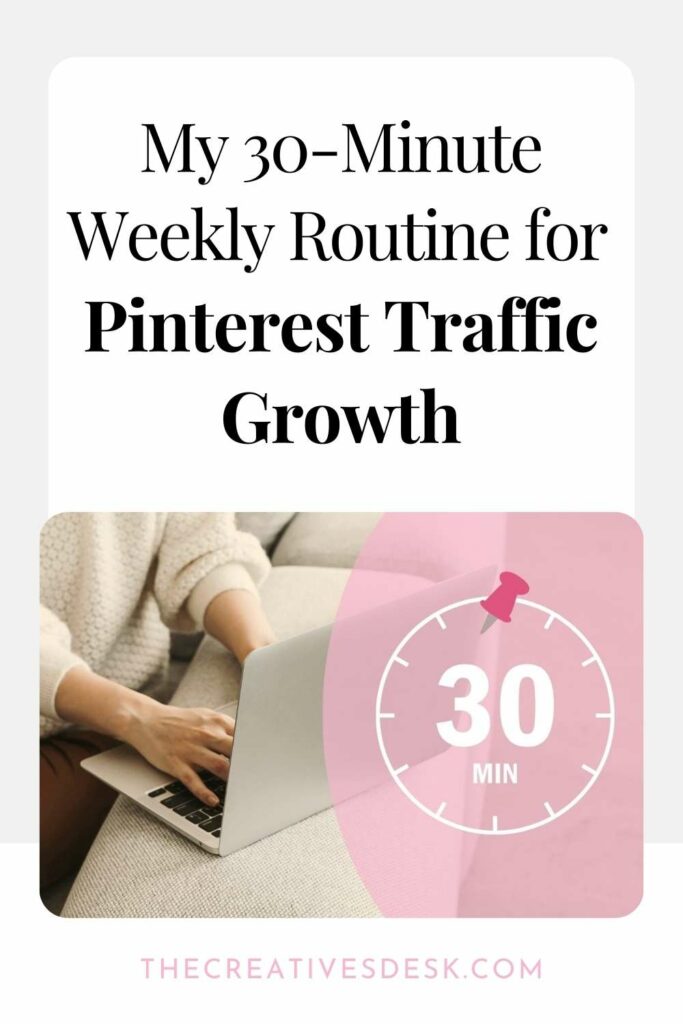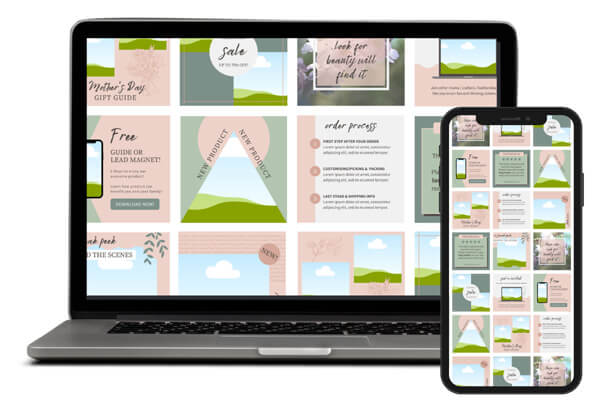

Pinterest is my favorite platform for getting organic traffic to my blog posts and product pages.
However, with Pinterest you really have to pin your content consistently and for a long time before you see any results.
Is it worth it? Yes, without a doubt!
I’ve already written about (and kept updated) my general strategy for Pinterest growth – where I record what’s currently working for me.
So in this post, I’m sharing my weekly pinning routine that helps me increase my Pinterest traffic in as little as 30 minutes a week.
If you prefer, you can divide these steps up into super short daily tasks, or even spend a couple of hours working on Pinterest each month.
Get started by spending the first few minutes creating fresh pins.
As I mentioned above, consistency is crucial on Pinterest, and pinning fresh content regularly helps keep your account active and relevant.
You can quickly create a few new pins using a tool like Canva, where you can design visually appealing pins that are optimized for Pinterest’s vertical format.
To save even more time, you can get a whole set of specially designed Pinterest Templates that you can easily edit all at once in Canva.
Make sure your images are high-quality, clear, and not overly fussy in their design as these tend to perform the best.
Use easy-to-read text for the pin’s title font and remember to include a call-to-action to encourage people to click through to your website.
For example, if you’re promoting a blog post, the text on your pin would be the post title or a teaser that hints at the solution you’re offering. Keep the text easy to understand and to the point.
For more design tips check out the following blog post that features several Pinterest pin design examples.
The next step is writing and optimizing your pin descriptions.
I like to keep a Google Sheet with a pin description for each individual page (URL) that I pin.
That way I can write, optimize and rewrite from the sheet and copy and paste when scheduling.
The important thing is to ensure you’ve included relevant keywords and hashtags specific to your niche as this is what makes your content discoverable in Pinterest searches.
Pinterest is essentially a visual search engine, and using SEO techniques can significantly increase the chances of your pins being seen by a wider audience. That’s why keywords in your descriptions should focus on what people might search for related to your content.
For example, if you’re promoting a post on kids’ crafts, include keywords like “kids craft ideas,” “indoor kids activities,” or “easy craft ideas for toddlers.”
Be strategic, but make sure the description still sounds natural and not stuffed with keywords. A good description explains the value of the content behind the pin and encourages people to click through.
If you like some more tips about Pinterest keywords read this fabulous guest post and find out what common mistakes to avoid when it comes to finding and using keywords in Pinterest.
The next stage is to schedule all the pins for the week.
This is when my Google Sheet comes into play. For each URL I have a column for pin title, pin description, the boards to pin to, and finally of course the link.
Having my pinning schedule organized like this ensures I don’t pin the same URL more than once a day and that I’m regularly pinning to ALL my boards. In general, it just means I’m less likely to forget to pin certain pages for months on end!
As I increased the amount of pins I was sharing and creating, I even added the Canva design link for each pin template set. Even though they’re all in my ‘Pinterest’ folder in Canva – it makes it easier to access them and means I don’t waste time searching for them (my Canva is messy!)
However, you don’t have to go that far, you can just use suitable text from the page your pin will link to and edit to optimize it whilst you’re uploading the pins to schedule.
You can of course also schedule straight from Canva. However, for me it’s slightly quicker to schedule my pins using the native Pinterest scheduler.
After you’ve scheduled your pins, it’s worth checking that your all boards are well-organized and are regularly being pinned too.
Spend a couple of minutes reviewing your boards each week/month, check for any gaps or inconsistencies, and make updates as necessary.
Make sure your boards cater to your niche or audience’s needs, and check each board has a keyword-rich description.
Strong, relevant board titles help with Pinterest SEO, making your pins more likely to be discovered in search results.
For example, instead of a generic board like “Recipes,” opt for something more specific, such as “Healthy Dinner Recipes” or “Chocolate Desserts.” The more specific and organized your boards are, the easier it will be for people to find your content.
The last few minutes of my weekly routine focuses on checking my analytics in Pinterest to see how my content is doing.
Reviewing your metrics regularly, even if just briefly, helps you understand which pins are performing well, which boards are gaining traction, and where your traffic is coming from.
Pinterest Analytics will show you impressions, saves, and clicks, giving you insight into which pins are driving the most traffic.
Look at your most popular pins to identify patterns – are there certain types of pins, designs, or topics that are driving more clicks? Are there any pins with high impressions but lower-than-expected clicks?
If you pay attention to these numbers, you can fine-tune your strategy and ensure that all your efforts move you closer to your traffic growth goals.
For example, if you notice that pins featuring how-to guides or listicles are getting more engagement, focus on creating more of that type of content. Similarly, if one of your boards is outperforming the others, you might decide to invest more time in curating and promoting that particular board.
If you make small, data-driven changes each week, you will steadily improve your performance and you’ll see a noticeable increase in your traffic over time.
Remember, the key is to stay consistent and responsive to what’s working. Pinterest is a long-term game, and growing traffic takes time, but with weekly or monthly attention given to your analytics, you’ll be able to make the right decisions that will get you better results.

Share to…

Sign up to get 10 free Canva templates for your social media.
Created with solopreneurs in mind, these templates offer a variety of content types to help boost your online presence!